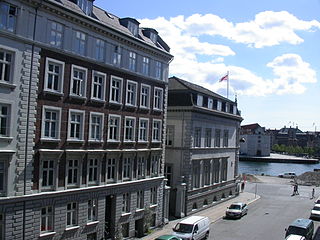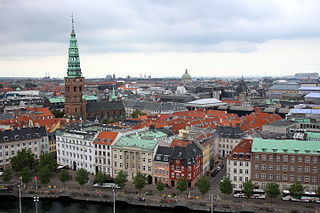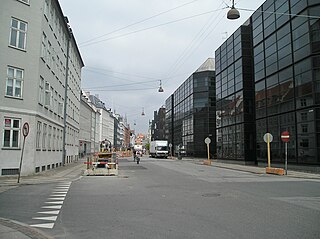
Gammelholm is a predominantly residential neighbourhood in the city centre of Copenhagen, Denmark. It is bounded by the Nyhavn canal, Kongens Nytorv, Holmens Kanal, Niels Juels Gade and the waterfront along Havnegade. For centuries, the area was the site of the Royal Naval Shipyard, known as Bremerholm, but after the naval activities relocated to Nyholm, it came under residential redevelopment in the 1860s and 1870s. The new neighbourhood was planned by Ferdinand Meldahl and has also been referred to as "Meldahl's Nine Streets". Apart from the buildings which face Kongens Nytorv, which include the Royal Danish Theatre and Charlottenborg Palace, the area is characterized by homogeneous Historicist architecture consisting of perimeter blocks with richly decorated house fronts.

Holmens Kanal is a short street in central Copenhagen. Part of the main thoroughfare of the city centre, it extends from Kongens Nytorv for one block to a junction with a statue of Niels Juel where it turns right towards Holmens Bro while the through traffic continues straight along Niels Juels Gade. The street was originally a canal, hence the name, but was filled in the 1860s. Today it is dominated by bank and government buildings.

Ved Stranden is a canal side public space and street which runs along a short section of the Zealand side of Slotsholmen Canal in central Copenhagen, Denmark. It begins at Holmens Kanal, opposite the Church of Holmen, and runs west along the canal for one and a half blocks before widening into a small, triangular space adjacent to Højbro Bridge and Højbro Plads. The name of the street refers to Gammel Strand, 'Old Beach', which it formed part of until 1961.

Stormgade is a street in central Copenhagen, Denmark. It runs from Frederiksholm Canal to H. C. Andersens Boulevard where it turns into Tietgensgade before continuing along the rear side of Tivoli Gardens and Copenhagen Central Station. In the opposite direction, Storm Bridge connects it to Slotsholmen where traffic may continue across Holmen's Bridge to Holmens Kanal, part of Ring 2, or across Knippel's Bridge to Christianshavn and Amager. The name of the street refers to the Swedish Storm of Copenhagen in 1659.

Bremerholm is a street in central Copenhagen, Denmark. It extends south from the major shopping street Strøget to Holmens Kanal. Together with Kristen Bernikows Gade, its extension to the north, it forms one of only two places where car traffic crosses pedestrianized Strøget on its way from Kongens Nytorv to the City Hall Square, the other being at Gammeltorv-Nytorv. The small square Magasins Torv is located in front of one of the entrances to the department store Magasin du Nord at the beginning of the street

Vingprdstræde is a street in the Old Town of Copenhagen, Denmark. The first part of the street passes the south side of the Magasin du Nord department store and the north side of Danske Bank's headquarters.

Admiralgade is a street in the Old Town of Copenhagen, Denmark. It runs from Nikolaj Plads in the north to Holmens Kanal in the south.

The Erichsen Mansion is a historic building located at Kongens Nytorv in central Copenahgen9, Denmark. It is now part of Danske Bank's headquarters.

The Peschier House is a listed property at Holmens Kanal in the Old Town of Copenhagen, Denmark. The building is currently part of Danske Bank's headquarters but it has been sold to Standard Life and the bank has announced its plans to move to new premises close to Copenhagen Central Station.

Christians Brygge is a waterfront and street in central Copenhagen, Denmark. It runs from the mouth of Slotsholmen Canal in the north to Langebro Bridge in the south where it turns into Kalvebod Brygge. Its northern end, which is located on the small isle of Slotsholmen, is connected to Niels Juels Gade and then Holmens Kanal by Christian IV's Bridge. Christians Brygge The road section is part of Ring 2. The name refers to Christian IV, king of Denmark during the first half of the 17th century, who constructed several buildings at the site, including the Arsenal and Christian IV's Brewhouse as well as nearby Børsen. Other landmarks along the quay include the Royal Danish Library and the mixed-use building BLOX, home to the Danish Architecture Centre.

Nyhavn 20, also known as the Boel House, is a listed property overlooking the Nyhavn canal in central Copenhagen, Denmark. A plaque on the facade commemorates that Hans Christian Andersen lived in the building when he had his first fairytale published.

Asylgade is a street in the Old Town of Copenhagen, Denmark. It runs from Vingårdstræde in the north to Laksegade in the south.
A. C. Bang is a furrier originally from Copenhagen, Denmark. It was founded in 1816 and had status of Purveyor to the Court of Denmark from 1905. Its former building, located at the corner of Østergade and Bremerholm, is from 1932–34 and was designed by Bent Helweg-Møller. It now consists of a shop in Zurich and a shop in Tokyo.

Ved Stranden 8 is a Neoclassical property located at the corner of Ved Stranden and Boldhusgade, opposite Christiansborg Palace, in central Copenhagen, Denmark. The building was listed on the Danish registry of protected buildings and places in 1932.

Boldhusgade is a short, cobbled street in the Old Town of Copenhagen, Denmark. It runs from Ved Stranden in the southwest to Admiralgade in the northeast from where it continues as Laksegade.

Lille Kongensgade is a back street located south of and roughly parallel with the Østergade section of Strøget in central Copenhagen, Denmark, linking Kongens Nytorv in the east with Nikolaj Plads in the west. The entire south side of the first part of the street is occupied by the Magasin du Nord department store.
Carl Christian Martens (1754–1820), variously referred to as Christian Martens and C. C. Martens, was a Danish master bricklayer and architect. He was elderman of the Bricklayers' Guild in Copenhagen and contributed to the rebuilding of the city in the years after the Copenhagen Fire of 1795. Most of his surviving buildings have been listed on the Danish Registry of Protected Buildings and Places.

Admiralgade 25/Laksegade 32 is a Neoclassical property situated at the corner of Admiralgade and Laksegade in central Copenhagen, Denmark. It was constructed for goldsmith Christian Nielsen Lindbach after his previous building on the site had been destroyed in the Copenhagen Fire of 1795. It was listed in the Danish registry of protected buildings and places in 1939.

Boldhusgade 2/Admiralgade 26 is a Neoclassical apartment building situated at the corner of Boldhusgade and Admiralgade in the Old Town of Copenhagen, Denmark. The building, like most of the other buildings in the area, was constructed as part of the rebuilding of the city following the Copenhagen Fire of 1795. Notable former residents include the army officer Bernhard Ditlef von Staffeldt. The building was later home to first the restaurant and bar venue Admiral-Krien and then the experimental theatre Boldhus Teatret. The building was listed in the Danish registry of protected buildings and places in 1939.

Admiralgade 28 is a Neoclassical building situated at the corner of Admiralgade and Boldhusgade in the Old Town of Copenhagen, Denmark. Constructed in 1798–99 by the prolific master builders Philip Lange and Lauritz Laurberg Thrane as part of the rebuilding of the city following the Copenhagen Fire of 1795., it is now part of a large complex of ministerial buildings which comprises the entire block. The building was listed in the Danish registry of protected buildings and places in 1950. Copenhagen's Student Association (Studenterforeningen) was based in the building from 1824 to 1831 and again from 1742 to 1863. Other notable former residents include the music retailers and publishers CCarl Christian Lose den ældre, merchant and Cherry Heering-manufacturer Peter Heering and the graphical studio Pacht & Crone.





















